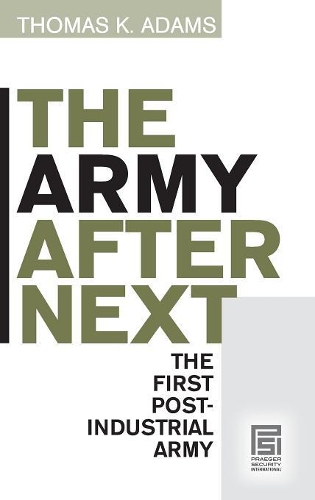
The Army after Next: The First Postindustrial Army
(Hardback)
Publishing Details
The Army after Next: The First Postindustrial Army
By (Author) Thomas K. Adams
Bloomsbury Publishing PLC
Praeger Publishers Inc
30th October 2006
United States
Classifications
Professional and Scholarly
Non Fiction
355.30973
Physical Properties
Hardback
336
Description
This book recounts the successes and failures of the US Army's Army Transformation program in the larger context of the Department of Defense's overall military transformation effort. Spurred by the belief that RMA represented the future, the Department of Defense (DoD) set out to transform the U.S. armed forces by adopting RMA concepts. Led by President George W. Bush and Defense Secretary Donald Rumsfeld, the DoD spent billions in an attempt to make the hypothetical capabilities real, changing the entire structure of the armed forces as a result. The services, the media, Congress, and the military industry each had its own agenda, all of which continue to come into play in the development of RMA strategies. The interplay of politics, technology, and military reality offers a fascinating narrative. Sure to be found controversial by some, compelling by all, this is the only available book-length examination of the way the U.S. Army and Department of Defense have tried to create the capabilities promised by the high-tech Revolution in Military Affairs. Of more immediate concern, it is also the only in-depth account of the effect RMA and transformation concepts had on the American operations in Afghanistan and Iraq. Many of the problems in both Iraq and Afghanistan, author Thomas K. Adams argues, arose from the DoD's implacable desire to implement RMA-driven transformation conceptswhether they were appropriate or not. What we need to do, he maintains, is to fight the war we have, not the war we want.
Reviews
Security consultant Adams attempts to analyze the revolution in military affairs (RMA) that began in the 1990s and how it impacted US forces in combat in the global war on terror. The author contends that the Department of Defense believed that RMAs, consisting primarily of technological innovations, could transform the US armed forces and thereby reduce conventional forces. He asserts that the former combined with new doctrine and organization could be employed to shock and stun an adversary with precision air power in such a way that its will and capability were shattered without the need for largescale ground combat. But as these superbly written 11 chapters illustrate, despite new and improved push-button warfare hardware, tactics, and doctrine, the global war on terror has proven that in the end infantry and heavy armor are the only existing ways to seize and hold ground against determined opposition. Highly recommended. All academic levels/libraries. * Choice *
[T]he Army after Next is spot on and Tom Adams is something of a prophet.[a] well-documented, well-reasoned, and well-written piece of work by a highly experienced practitioner. This book should be mandatory reading for citizens as well as decision-policy-and opinion makers. At base, The Army after Next deals with the issue of security--our security. Too few of us have paid much attention. Pay attention now. * Parameters *
In recent years, many military theorists became convinced that new information technologies were generating a revolution in military affairs (RMA). In response, the Department of Defense undertook to transform the U.S. Armed Forces by adopting RMA concepts. In this study, national security consultant Adams critically examines the U.S. Army's attempts to make this hypothetical revolution a reality. Particular attention is paid to the effects of RMA concepts on American operations in Afghanistan and Iraq. * Reference & Research Book News *
Author Bio
Thomas K. Adams is a national security consultant based in the Washington, DC area. He is the author of US Special Operations: The Challenge of Unconventional Warfare and numerous articles dealing with military and national security subjects. He is a veteran of 34 years military service, principally in intelligence and special operations at tactical, operational, and strategic levels from Vietnam to Bosnia. Later, as a civilian, he assisted and supported counterterrorist investigations worldwide.
